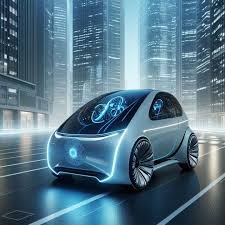The Future of Self-Driving Vehicles: A Sustainable Revolution on Wheels

Strong 8k brings an ultra-HD IPTV experience to your living room and your pocket.
Introduction
The advent of self-driving vehicles marks a transformative shift in how we think about transportation. As the world grapples with environmental challenges, the integration of autonomous technology offers a promising solution that aligns with sustainability goals. This article delves into the intersection of sustainability and self-driving cars, exploring how these innovative vehicles can contribute to reduced emissions and more efficient energy use.
The Rise of Self-Driving Vehicles
Understanding Autonomous Technology
Self-driving vehicles, or autonomous vehicles (AVs), use a combination of sensors, cameras, artificial intelligence, and machine learning to navigate without human intervention. With companies like Waymo, Tesla, and Uber leading the charge, AV technology is rapidly advancing. But beyond convenience, these vehicles hold the potential for significant environmental benefits.
Current Landscape of Transportation Emissions
Transportation is a major contributor to greenhouse gas emissions, accounting for nearly 29% of total emissions in the United States. Traditional vehicles rely heavily on fossil fuels, leading to air pollution and climate change. As cities expand and populations grow, the need for cleaner, more efficient transportation solutions becomes increasingly urgent.
The Environmental Benefits of Self-Driving Vehicles
1. Reduced Emissions
One of the most significant advantages of self-driving vehicles is their potential to lower emissions. By optimizing driving patterns, autonomous cars can:
• Eliminate Stop-and-Go Traffic: Self-driving cars can communicate with each other and traffic systems to reduce congestion, minimizing unnecessary idling and braking, which contribute to emissions.
• Smooth Acceleration and Deceleration: Autonomous vehicles can maintain optimal speeds, leading to more efficient fuel consumption. Studies suggest that AVs could reduce greenhouse gas emissions by up to 50% compared to traditional vehicles.
2. Efficient Energy Use
Self-driving vehicles can also enhance energy efficiency through:
• Carpooling and Ride-Sharing: AVs can facilitate shared transportation, reducing the number of cars on the road. A reduction in the overall vehicle count translates to lower emissions and less energy use.
• Integration with Electric Vehicles (EVs): Many autonomous vehicles are being designed as electric. EVs produce zero tailpipe emissions and, when powered by renewable energy sources, can significantly decrease the overall carbon footprint of transportation.
3. Improved Urban Planning
The deployment of self-driving vehicles can influence urban design in sustainable ways:
• Reduced Need for Parking: Autonomous vehicles can drop passengers off and park themselves in less central locations, freeing up valuable urban land for parks, green spaces, or affordable housing.
• Smart Traffic Management: Integrating AVs into existing traffic systems can lead to smarter, more efficient routing, reducing the overall demand for road space and contributing to lower emissions.
The Intersection of Technology and Sustainability
Advanced AI and Machine Learning
The technology behind self-driving vehicles relies heavily on advanced algorithms and machine learning. These systems continuously learn from data, enabling AVs to optimize their routes and driving patterns in real-time. As they gather more data, they can further reduce energy consumption and emissions.
Vehicle-to-Everything (V2X) Communication
V2X communication allows vehicles to communicate with infrastructure, other vehicles, and even pedestrians. This technology can significantly enhance traffic flow and safety, reducing the need for aggressive driving maneuvers that waste fuel and increase emissions.
Sustainable Manufacturing Practices
The environmental impact of self-driving vehicles isn't limited to their operation. The manufacturing process also plays a crucial role. Many companies are adopting sustainable practices, such as:
• Using Recyclable Materials: Manufacturers are increasingly focusing on using materials that can be recycled, reducing waste and promoting a circular economy.
• Energy-Efficient Production: Investing in energy-efficient manufacturing processes helps to minimize the carbon footprint associated with producing new vehicles.
Challenges and Considerations
1. Infrastructure Needs
To fully realize the environmental benefits of self-driving vehicles, substantial investments in infrastructure are necessary. Smart traffic signals, charging stations for EVs, and dedicated lanes for autonomous vehicles are just a few examples of what will be required. Without proper infrastructure, the full potential of AVs may not be unlocked.
2. Public Perception and Adoption
While many view self-driving cars as the future, public acceptance remains a hurdle. Concerns about safety, reliability, and the ethical implications of autonomous decision-making must be addressed. Building public trust through education and transparent communication is essential for widespread adoption.
3. Regulatory Framework
Creating a regulatory framework that supports the safe deployment of autonomous vehicles while addressing environmental goals is crucial. Policymakers need to establish guidelines that promote sustainable practices in the development and operation of AVs.
The Role of Policy and Regulation
Incentivizing Sustainable Practices
Governments can play a vital role in promoting the environmental benefits of self-driving vehicles through:
• Tax Incentives for Electric AVs: Encouraging consumers to purchase electric self-driving cars can accelerate the transition to cleaner transportation.
• Funding for Research and Development: Investing in R&D for sustainable technologies and infrastructure can lead to innovations that further reduce the environmental impact of AVs.
Collaboration Between Public and Private Sectors
Collaboration between governments, businesses, and communities is essential for successfully integrating self-driving vehicles into the transportation ecosystem. By working together, stakeholders can develop strategies that prioritize sustainability while also addressing safety and efficiency.
The Future of Mobility
A Paradigm Shift in Transportation
The rise of self-driving vehicles signifies a paradigm shift in how we think about mobility. As these vehicles become more prevalent, they offer an opportunity to reimagine our cities and transportation systems. The potential for reduced emissions and efficient energy use aligns perfectly with global sustainability goals.
Embracing Innovation for a Sustainable Future
Embracing autonomous technology is not just about improving transportation efficiency; it's about building a sustainable future. By investing in self-driving vehicles, we can pave the way for cleaner air, reduced traffic congestion, and a more livable planet for future generations.
Conclusion
The intersection of sustainability and self-driving vehicles presents a unique opportunity to address some of the most pressing environmental challenges of our time. By leveraging advanced technology and fostering a culture of innovation, we can create a transportation system that is not only efficient but also environmentally responsible. As we move toward an increasingly automated future, it's imperative that we prioritize sustainability in the development and deployment of self-driving vehicles, ensuring that they contribute positively to our planet and our communities. The future of mobility is here, and it’s driving toward a greener tomorrow.
View the entire post: https://www.nextmsc.com/blogs/The-Future-of-Self-driving-Vehicles
Note: IndiBlogHub features both user-submitted and editorial content. We do not verify third-party contributions. Read our Disclaimer and Privacy Policyfor details.


